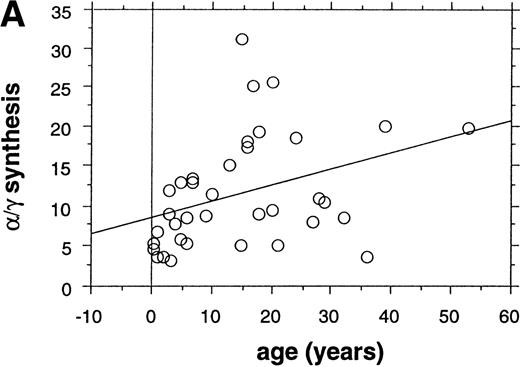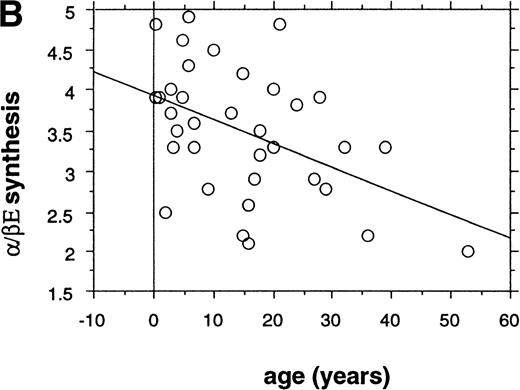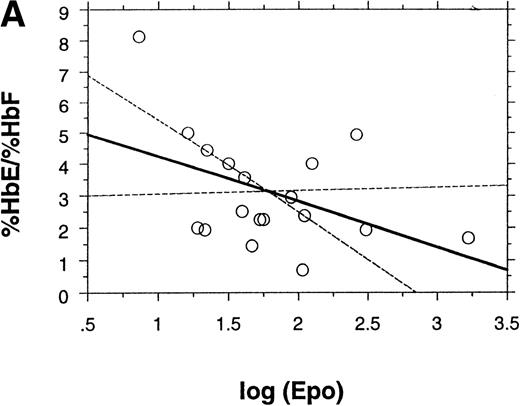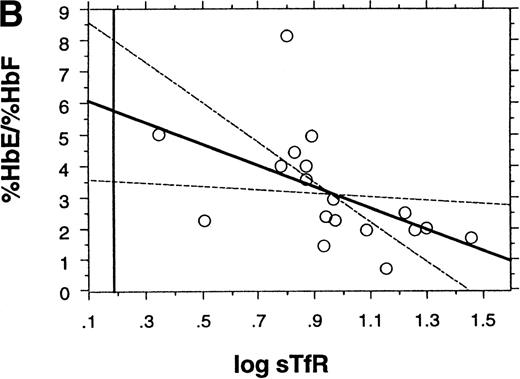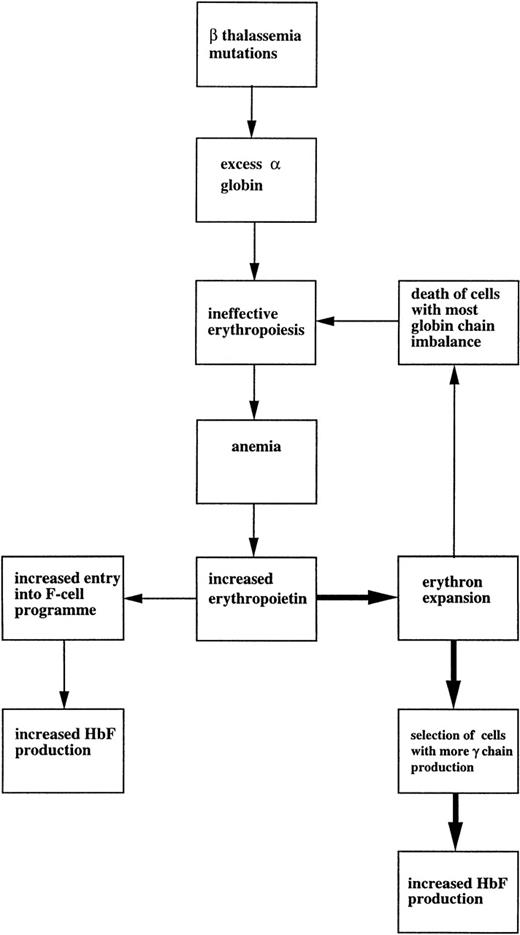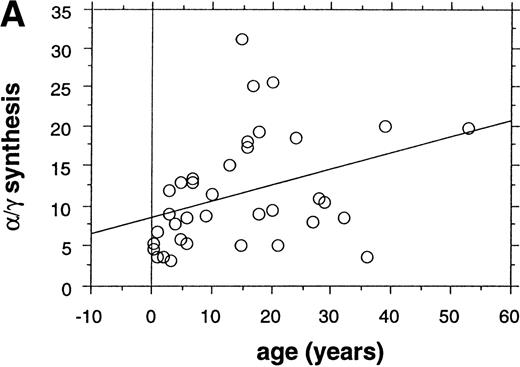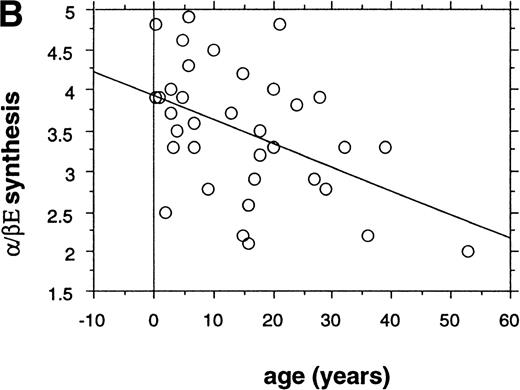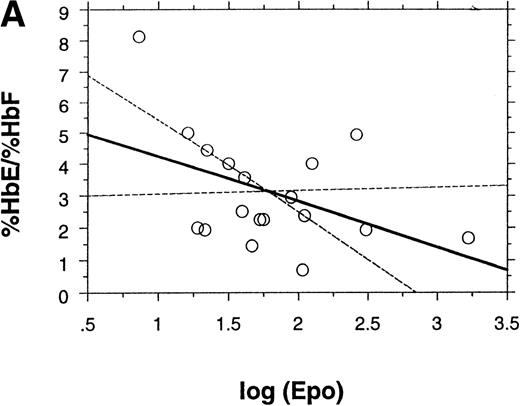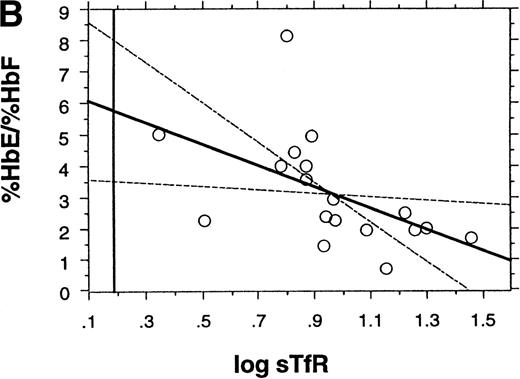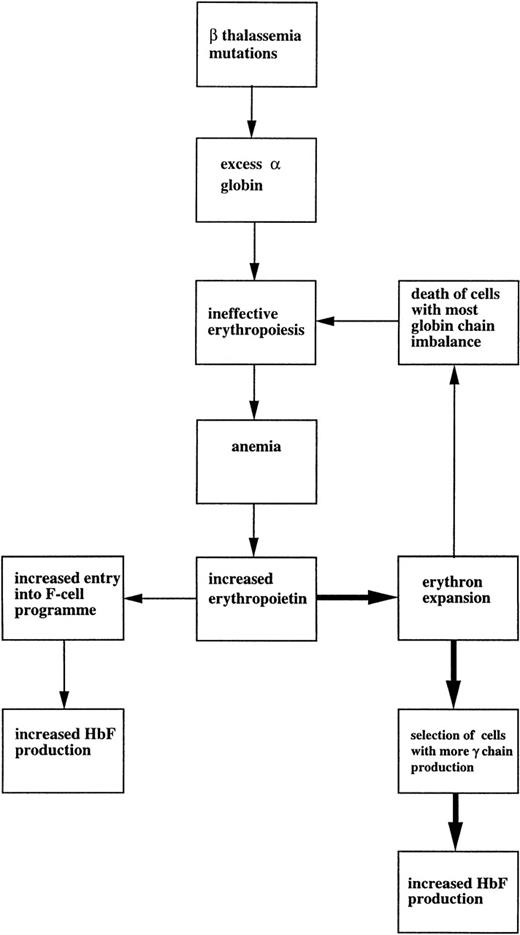Abstract
To try to further define the mechanisms that increase the levels of hemoglobin F (HbF) in the blood of patients with severe forms of β thalassemia, we have studied two comparable populations of hemoglobin E (HbE)/β thalassemics, one regularly transfused and one receiving only occasional blood transfusions. Regular transfusion was associated with a significant decrease in soluble transferrin receptor and erythropoietin levels. Globin chain synthesis studies also show a highly significant decrease in HbF synthesis relative to HbE in the transfused patients. This effect was confirmed by sequential data on one patient, studied before and after the commencement of regular blood transfusion; blood transfusion was followed by a marked increase in the /γ, βE/γ, and HbE/HbF ratios. These data suggest that the high HbF levels in HbE/β thalassemia, and other β thalassemia syndromes, result from increased erythropoietin levels leading to bone marrow expansion, and possibly increased F-cell production, combined with ineffective erythropoiesis giving a survival advantage to F cells. This study also suggests that alteration in blood transfusion regimes must be taken into account when interpreting changes in HbF levels seen in trials of HbF-promoting drugs.
HEMOGLOBIN F (HbF, α2γ2) accounts for up to 90% of the circulating hemoglobin at birth. Its synthesis starts to decline during the third trimester, and over the first year of life it is gradually replaced by adult hemoglobin, HbA (α2β2). Normal adults have less than 1% of HbF, apparently confined to a subset of red blood cells called F cells,1 which constitute about 3% of the erythrocytes.2 Several inherited and acquired conditions are associated with the persistence or the reactivation of HbF production.
Most of the genetic disorders associated with persistent HbF production involve alterations of the structure of the β globin cluster. The highest adult levels of HbF are seen in β and δβ thalassemia, or hereditary persistence of fetal hemoglobin (HPFH), in which HbF can constitute up to 100% of the hemoglobin. It is now clear that HPFH is an extremely heterogeneous group of conditions, some of which result from deletions of the β globin gene or point mutations in the γ globin gene promoter regions, whereas others arise from genetic determinants that segregate independently of the β globin gene cluster.3 The only other inherited disorder that is associated with increased levels of HbF is sickle cell disease, although in this case the level of HbF usually constitutes only between 5% and 20% of the total hemoglobin.
Several acquired conditions are associated with modest elevations of HbF. They include pregnancy, recovery from marrow hypoplasia, aplastic anemia, leukemia, thyrotoxicosis, hepatoma, and juvenile chronic myeloid leukemia.4 The latter condition is exceptional in that it seems to reflect a genuine reversion to fetal erythropoiesis.5 The remainder seem to be examples of the transient reactivation of HbF under conditions of acute erythropoietic stress, that is, rapid expansion of the erythron.6
Although progress has been made towards an understanding of the persistence of HbF production in some forms of HPFH, and there are some pointers towards the regulatory regions of the β globin gene cluster involved, less is known about the factors that cause elevated levels of HbF in β thalassemia and sickle cell disease. It has been suggested that the combination of erythroid expansion and selection of red blood cell precursors and/or red blood cells able to synthesize γ chains may, alone, be sufficient to explain this phenomenon.4However, these mechanisms have not been explored formally, and it is still not clear whether there is, in addition, an absolute increase in the amount of γ globin production in these disorders.
We have tried to dissect some of the factors involved in the high levels of HbF in the β thalassemia syndromes by studying the effects of blood transfusion on HbF production in HbE/β thalassemia. This disorder, one of the commonest forms of β thalassemia worldwide, is characterized by a remarkable and largely unexplained variation in its clinical phenotype, and hence both transfusion-dependent and untransfused patients with similar genotypes are available for study.7 8 Furthermore, the peripheral blood consists mostly of HbE and HbF in varying ratios, and thus it is possible to compare the production of HbF relative to HbE, even in transfused patients. As well as providing information about the mechanisms of HbF production in β thalassemia, this study is designed to learn more about the overall effects of transfusion on HbF production, information which is of particular importance because patients who are entering trials of potential HbF-raising drugs often have alterations in their transfusion programs either before or during the period of the trial.
MATERIALS AND METHODS
Patients.
A total of 45 patients with genotypically proven HbE/β thalassemia were studied. Nearly half were of Bangladeshi origin (44%), the remainder coming mainly from India and Pakistan. All were residents in the United Kingdom, but attended about 20 different hospitals. The mean age was 15.4 years (range, 0.5 to 59 years), and 42% were female. Approximately half received regular blood transfusions of varying frequency. The remainder received occasional blood transfusions and had not been transfused for more than 3 months before being studied. The IVS 1-5 G-C severe β+ thalassemia allele was the commonest mutation (51%), with a selection of different β0 thalassemia mutations making up the remainder. Splenectomy had been performed in 40% of the patients. One patient was studied at the age of 2.8 years, when he was untransfused, and again at the age of 6 years, having been regularly transfused for more than a year. Blood transfusions were started for growth failure. All patients gave informed consent.
Hematological analysis.
Venous blood was collected into EDTA, and blood counts were performed on an automated cell counter. Reticulocyte counts were performed on blood films after staining with brilliant cresyl blue.9HbF, HbE (together with HbA2), and HbA were quantitated either by cation exchange globin chain separation or hemoglobin cation exchange high performance liquid chromatography (HPLC) (Bio-rad Variant, Hercules, CA).
Heparinized serum was stored at −20°C until immediately before analysis. Concentrations of soluble transferrin receptor (sTfR) and erythropoietin (Epo) were measured using enzyme-linked immunosorbent assays (ELISAs; R&D Systems, Abingdon, UK).
DNA analysis.
DNA was isolated from peripheral blood leukocytes by phenol-chloroform extraction. The β thalassemia mutations were identified using allele-specific amplification by the polymerase chain reaction (PCR).10 α thalassemia was screened for using Southern blotting.11 The XmnIG γ globin polymorphism was detected by PCR amplification and restriction enzyme digestion.12
Globin chain biosynthesis.
Twenty milliliters of venous blood was taken into heparin from each subject. The untransfused patients were studied in the steady state, at least 3 months after any blood transfusion, and the regularly transfused patients were studied less than 3 days before their next transfusion. Blood was kept on ice until analyzed, a maximum of 2 hours. The cells were washed, and ultracentrifuged to concentrate the reticulocytes, and white blood cells were removed using α-cellulose and microcrystalline cellulose (Sigma Chemical Co, Poole, Dorset, UK).13 0.4 mL of the reticulocyte-enriched red blood cells were incubated with 1 mL leucine-free plasma-based incubation medium14 and 200 μCi of L-[4,5-3H] leucine (Amersham International plc, Little Chalfont, Bucks, UK). The incubation was continued for one hour at 37°C, and terminated by washing the cells three times in cold reticulocyte saline (0.13 mol/L NaCl, 0.005 mol/L KCl, 0.007 mol/L MgCl2). Globin was prepared by acid-acetone precipitation at −20°C, and the globin chains were separated using cation exchange chromatography and a convex, three-chambered gradient, producing approximately 120 fractions.15 The radioactivity incorporated into each fraction was measured by scintillation counting, and the areas under the γ, βE, and α globin chains were calculated.14 The ratios of α/non-α, α/βE, βE/γ, and α/γ globin chain production were thus calculated. The amount of βAsynthesis in patients with the HbE/IVS 1-5 genotype was too small to be reliably used in calculating individual ratios, but was included in the α/non-α ratio.
Statistical analysis.
Univariate regression analysis was performed on the various globin chain synthesis ratios against age, sex, presence of a spleen, transfusion status, Xmn1 polymorphism, and β0 or β+ thalassemia mutation. Factors found to be significantly associated with the outcome variable (P < .05) were entered into a multiple regression analysis. The transfused and untransfused groups were compared for various factors using unpaired two-tailed T-tests and χ2-tests, as appropriate. The effect of blood transfusion on sTfR, Epo, and reticulocyte levels was also assessed using unpaired two-tailed T-tests. sTfR and Epo were not normally distributed, and therefore were normalized by log10 transformation before analysis. The SPSS (SPSS Inc, Chicago, IL) and Statview (Abacus Concepts Inc, Berkeley, CA) computer programs were used.
RESULTS
Patient groups.
There were no significant differences between the regularly transfused and untransfused groups for the following parameters: age (P = .33), sex (P = .94), frequency of β0 or β+ thalassemia mutations (P = .87), frequency of the Xmn1 polymorphism (P = .24), and age at presentation with thalassemia (P = .81). Splenectomy was significantly more common in the regularly transfused patients compared with the untransfused patients (67% transfused and 25% untransfused had been splenectomized; χ2 = 7.88, P = .005). There were only two cases of deletional α+ thalassemia found, one in the transfused and one in the untransfused group. Their exclusion from the analysis did not significantly alter the results.
Hematology.
The mean pretransfusion Hb in the regularly transfused group was 9.6 g/dL (range, 4.7 to 13.2 g/dL). The considerable variation reflects the wide range of transfusion regimens used in the different hospitals. The mean Hb in the untransfused group was 7.6 g/dL (range, 4.6 to 10.5 g/dL), significantly lower than in the transfused group (P = .002). The effects of blood transfusion on reticulocytes, Epo, and sTfR are summarized in Table 1; blood transfusion significantly reduces all three values.
Globin chain biosynthesis.
Globin chain synthesis was successfully performed on 36 patients (13 transfused). In two patients, it failed on two separate occasions, apparently because of complete suppression of erythropoiesis. Univariate regression analysis showed that none of the following factors were significantly associated with variation in the total α/non-α globin chain synthesis ratios: age (P = .62), sex (P = .94), splenectomy (P = .72), transfusion dependence (P = .36), β0 or β+thalassemia mutation (P = .41), or the Xmn1polymorphism (P = .83). The mean α/non-α ratio for all patients was 2.4 (range, 1.4 to 3.3).
Univariate regression analysis showed that for the α/βE, βE/γ, and α/γ ratios, both age and transfusion status significantly contributed to the variation in all ratios (Table 2 and Fig 1). Sex, splenectomy, β0 or β+ thalassemia mutation, and theXmn1 polymorphism did not contribute significantly to any of the variation. Regular blood transfusion is associated with a decrease of γ globin synthesis and an increase in βE globin, both relative to α globin synthesis. Increasing age is associated with similar changes in biosynthesis ratios, in both transfused and untransfused patients. Multiple regression analysis of age and transfusion status against the various globin chain ratios is summarized in Table 3. Both factors are significant for one or more of the ratios, and together explain 20% to 30% of the variance.
The relationship between globin chain synthesis ratios and age in HbE/β thalassemics. γ chain synthesis decreases relative to , and βE increases relative to with increasing age. (A) /γ ratios = 8.6 + (0.2 × age), R = .36, P = .029. (B) /βE = 3.9 − (.029 × age), R = −.47, P = .004.
The relationship between globin chain synthesis ratios and age in HbE/β thalassemics. γ chain synthesis decreases relative to , and βE increases relative to with increasing age. (A) /γ ratios = 8.6 + (0.2 × age), R = .36, P = .029. (B) /βE = 3.9 − (.029 × age), R = −.47, P = .004.
Hemoglobin ratios.
There is minimal HbE or HbF in transfused blood, making it possible to monitor the ratios of these two hemoglobin types in both the transfused and untransfused patients. The ratio of HbE/HbF is significantly higher in the regularly transfused patients, reflecting the relative reduction of γ chain synthesis seen also in the globin chain synthesis ratios. The HbE/HbF ratio in the regularly transfused patients also correlates significantly with the log sTfR (R = −.53, P = .022) and log Epo (R = −.44, P = .065) (Fig 2), a relationship not seen in the untransfused patients (Fig 2).
The relationship between HbE/HbF ratio and Epo and sTfR in regularly transfused HbE/β thalassemics. In both cases, the ratio decreases with increasing sTfR and Epo levels, suggesting that the degree of reduction of HbF synthesis is proportional to the degree of erythroid suppression. The dotted lines follow 95% CI for the slope. The vertical line in (B) denotes in mean log sTfR in HbE trait (0.18). (A) %HbE/HbF = 5.6 − (1.41 × log Epo), R = −.44,P = .065. (B) %HbE/%HbF = 6.4 − (3.43 × log sTfR),R = −.53, P = .022.
The relationship between HbE/HbF ratio and Epo and sTfR in regularly transfused HbE/β thalassemics. In both cases, the ratio decreases with increasing sTfR and Epo levels, suggesting that the degree of reduction of HbF synthesis is proportional to the degree of erythroid suppression. The dotted lines follow 95% CI for the slope. The vertical line in (B) denotes in mean log sTfR in HbE trait (0.18). (A) %HbE/HbF = 5.6 − (1.41 × log Epo), R = −.44,P = .065. (B) %HbE/%HbF = 6.4 − (3.43 × log sTfR),R = −.53, P = .022.
Sequential data.
One patient was studied when he had never been transfused (age 2.8 years) and again when on a monthly transfusion regimen (age 6 years). He had the IVS 1-5 G-C β thalassemia mutation, was Xmn1+/−, and had not been splenectomized. The results are summarized in Table 4. Because of the effect of age on synthesis ratios, regression analysis was used to calculate the expected ratios if transfusion had not been started; the regression was based on data from the 13 untransfused patients, age 10 or under. In the transfused state, the γ chain synthesis is significantly lower relative to α, compared both to his untransfused state and to the predicted ratios for his age.
DISCUSSION
The decline of γ chain synthesis, relative to βE, with increasing age seems to continue well beyond childhood and throughout adult life (Fig 1). This relationship is not derived from sequential data on the same patients, and therefore could result from other factors such as cohort effects or the earlier deaths of patients with higher HbF levels; there is no plausible reason to expect either of those factors to operate, and indeed it might be expected that patients making more HbF would have a survival advantage. It therefore seems likely that this correlation with age represents a delayed switching from γ chain to βE production. This presumably is similar to the previously noted decline in HbF levels with age in normal individuals16 and also in sickle cell disease,17 although the absolute fall in HbF is considerably amplified by thalassemia.
There is a highly significant difference between the globin chain synthesis ratios of the regularly transfused and untransfused groups of patients. Although the α/non-α synthesis ratios do not differ, γ chain synthesis is significantly lower relative to βE in the transfused group. This observation is supported by the finding that the ratios of the circulating levels of HbE and HbF in the regularly transfused patients also show a relative decrease in HbF (or increase in HbE).
There are two possible interpretations of this finding. It could be that the regularly transfused patients have an innately more severe form of HbE/β thalassemia than those patients receiving only occasional blood transfusions. We have previously shown that there is a significant positive correlation between total hemoglobin and %HbF in Indian patients with HbE/β thalassemia,7 and therefore an increased capacity to make more HbF should lessen the severity of the disease. In general, it would be expected that more anemic patients would be most likely to be started on regular blood transfusions. This may be the explanation for some of the difference. However, there were no significant differences between the transfused and untransfused groups with respect to many of the factors known to be associated with disease severity, including β thalassemia mutations, α thalassemia, the Xmn1 polymorphism,18 and the age at presentation with thalassemia (regularly transfused 3.8 years, untransfused 4.3 years, P = .81). Equally, the transfusion practice varied widely from hospital to hospital, and blood transfusions were initiated for a wide range of indications, many of which would not be universally accepted as appropriate. It therefore seems unlikely that difference in disease severity is the main explanation for the marked reduction of HbF synthesis in the regularly transfused patients.
The second and more likely possibility is that the blood transfusions themselves lead to a relative reduction in γ globin synthesis. There is evidence to support this. Most directly, the sequential data on a single patient, before and after regular transfusions, shows a very marked reduction in γ chain synthesis relative to βE(Table 4). The studies on this patient were separated by 3 years (age 3 years to age 6 years), but the relative decrease in HbF is much greater than that predicted by regression analysis of untransfused patients over the same period. Although the regression analysis gives a very approximate estimate of the patient’s potential HbF level if he had remained untransfused, the increase in α/γ ratio over this time (8.9 to 29) far exceeds any possible change associated with aging alone. It would be informative to study more patients before and after transfusion, and in particular to look at the time course of any suppression of γ chain synthesis. There is also a good negative correlation between the HbE/HbF ratio and log sTfR in the transfused patients; sTfR has been shown to correlate with the mass of erythroid tissue by ferrokinetic studies,19 and therefore, this finding indicates that increasing transfusion-induced erythroid suppression is associated with decreasing HbF synthesis. This raises the theoretical possibility that the early use of regular blood transfusions in β thalassemia might accelerate the switch from HbF synthesis and worsen the phenotype of the disease.
It is surprising that the α/βE ratio shows a change reciprocal to the α/γ ratio, falling from 3.8 in the untransfused patients to 3.0 in the regularly transfused. Clearly, this must reflect either a change in the relative rates of production of γ and βE chain synthesis in the red blood cell precursors, or a perturbation of the heterogeneous erythroid population in the peripheral blood, consequent on transfusion. If it reflects the rates of globin chain synthesis, it implies that there is a reciprocal relationship between γ and βE chain synthesis in the red blood cell precursors, and that if γ chain synthesis is depressed, there is relatively more β chain production. It could also result from the appearance in the peripheral blood of reticulocytes with a greater propensity for βE chain production, consequent on the suppression of the red blood cell populations that synthesize relatively more γ globin. However, one might expect that the precursors of such cells would have more globin chain imbalance, and it is difficult to see why more of them would reach the peripheral blood if the HbF-rich population is suppressed. Interestingly, a similar reciprocal relationship is seen between the two ratios with increasing age (Table 3, Fig 1), and a trial of hydroxyurea in HbE/β thalassemia observed that higher levels of HbF were accompanied by a complimentary fall in the amount of HbE, with no net increase in total hemoglobin.20
This study facilitates the analysis of globin chain synthesis in HbE/β thalassemic subjects in the absence of a highly expanded erythron and high erythropoietin levels. Under these circumstances, although HbF production is increased relative to nonthalassemic subjects, it is significantly reduced compared with the untransfused population. This suggests that erythron expansion secondary to erythropoietin stimulation is an important mechanism for maintaining the exceptionally high levels of HbF in HbE/β thalassemia, and presumably other β thalassemia syndromes.
There are two possible mechanisms. First, it may simply reflect an expansion of the F-cell population, which, because of its relative reduction in globin chain imbalance, comes under increased selection. Alternatively, there may be an absolute increase in HbF production by F cells in these expanded marrows. Or, both mechanisms may be involved. In the first model, the absolute numbers of F-cell progenitors would expand, proportionate to the increase in all red blood cell precursors. In both transfused and untransfused patients, the F-cell precursors would have a selective advantage because of their lesser degree of globin chain imbalance, leading to the observed increases in HbF levels. Although the absolute number of F-cell precursors would decrease after blood transfusion, the selective process itself would not be altered, and the ratio of F reticulocytes to normal reticulocytes, and also the α/γ globin chain synthesis ratio, would remain constant. However, the observed change in α/γ ratio is not compatible with this mechanism alone, and suggests the possibility that there is a genuine increase in HbF and/or F-cell production. This preferential production of F reticulocytes has typically been thought to be important in acute increases in Epo, rather than the chronic elevations seen in thalassemia,6,21but the selective advantage of developing F cells in thalassemia could emphasize this effect in chronic erythropoietic stress. This proposed mechanism is summarized in Fig 3. Although we did not directly measure F cells and F reticulocytes in this study, %HbF has been previously shown to correlate well with F cells,2 and it is reasonable to suppose that the α/γ globin chain synthesis ratios, which are determined by γ chain synthesis in reticulocytes, measure the same processes reflected by F-reticulocyte counts. However, there is inevitably an element of speculation in this model.
Proposed mechanism for increased HbF production in β thalassemia syndromes.
Although regular blood transfusions reduce sTfR and Epo levels, they do not reduce either to levels seen in normal individuals (0.85 to 3.1 mg/L) or HbE trait (1.2 to 2.4 mg/L).22 The mean sTfR in the transfused (10.2 mg/L) and untransfused (20.7 mg/L) groups suggests, on average, a halving of the erythron size. Extrapolation from linear regression of the relationship between the HbE/HbF ratio and log sTfR in the transfused patients (Fig 2B) suggests that if there were no erythroid expansion in HbE/β thalassemia (sTfR = 1.5 mg/L, log sTfR = 0.176), the HbE/HbF ratio would be about 6 (95% confidence interval [CI] 3.5 to 8.5). This is considerably less than the HbE/HbF ratio seen in HbE heterozygotes, who typically have less than 1% HbF and 30% HbE (ratio >30).23 This calculation, albeit approximate, suggests that marrow expansion alone does not explain the high HbF levels. Selection of developing F cells is likely to be the main factor, even when erythropoiesis is reduced to normal levels; if there is any contribution by an increased output of HbF/F cell, it must be small. None of the β thalassemia mutations observed in this study were ones that have been noted to have an effect on raising the levels of HbF production in heterozygotes.
The implications of this study extend beyond HbE/β thalassemia. The mechanisms of erythropoietin-driven bone marrow expansion and ineffective erythropoiesis with selection of F cells should apply equally to the high HbF levels seen in other forms of β thalassemia intermedia and major. The same forces apply to a different degree to the more moderate elevations of HbF seen in sickle cell disease. Increased erythropoietin levels, erythroid expansion, and ineffective erythropoiesis are less marked, leading to reduced intramedullary selection of F cells, but greater survival advantage of the F cells in the peripheral blood.24 This study also lends support to the importance of erythropoietin in increased HbF production in thalassemia syndromes, and by implication confirms the potential benefit of recombinant erythropoietin as a therapeutic agent in thalassemia.25
This study also has important implications for studies of HbF-promoting drugs. It is implicit from this study that stopping blood transfusions will lead to increased HbF production, as Epo levels increase and the bone marrow starts to expand. Many clinical trials of HbF-promoting drugs will inevitably involve reductions of blood transfusion regimes, which in themselves might provoke higher HbF levels that could be attributed to the drugs. It is therefore important to control for changes in blood transfusion when performing these studies, particularly as many of the changes in HbF synthesis in this study are greater than those reported in pharmacological studies. Many of the latter unavoidably use mixtures of transfused and untransfused patients, or patients on differing transfusion regimes.20 26 Changes in blood transfusion regimes could both promote HbF synthesis, which would be attributed to the drug under trial, or mask a beneficial increase.
ACKNOWLEDGMENT
The following people kindly allowed us to study their patients: M.L. Tiller, S.C. Davies, S.L. Thein, J.P. Darbyshire, J. Wilde, C. Hatton, D.S. Thompson, R.F. Stevens, P. Daish, A. Yardumian, C. Mitchell, D.M. Layton, I.R. Samaratunga, A. Britland, A.J. Steed, A. Newsome, D.A. Winfield, A. Lorek, S. Allard, and T.C. Pearson.
Supported by the Medical Research Council, London, UK.
The publication costs of this article were defrayed in part by page charge payment. This article must therefore be hereby marked “advertisement” in accordance with 18 U.S.C. section 1734 solely to indicate this fact.
REFERENCES
Author notes
Address reprint requests to D.C. Rees, MRCP, Department of Haematology, Royal Hallamshire Hospital, Glossop Rd, Sheffield, S10 2JF, UK.

